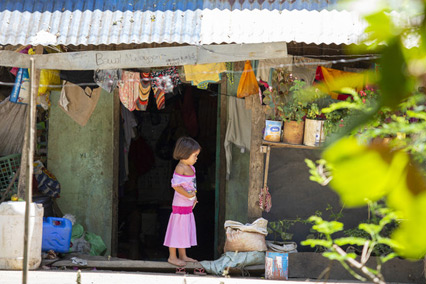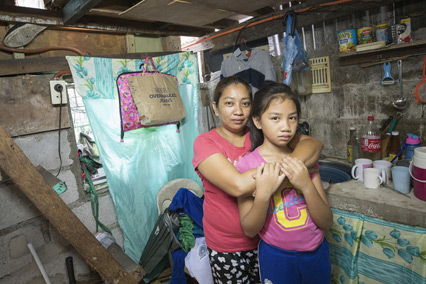Site will be
unavailable for maintenance from June. 4, 11:30 p.m., to June 5, 12:30 a.m. ET. Thank you for your
patience!
Online Sexual Exploitation During COVID-19
Posted on 07/21/2020
By: Danielle Lilly, Policy Advisor, ChildFund International, and Isabelle E. Ereñeta, Program and Sponsorship Director, ChildFund Philippines
“It really pained my heart,” says Masipag*, a Filipina teenager who was first sexually exploited online when she was 12 years old. “I kept asking myself, why did this happen to me?”
Since the onset of the COVID-19 pandemic, public and media attention has largely centered on public health challenges and economic repercussions. However, there are secondary impacts that are no less devastating, including the online sexual exploitation and abuse of children (OSEAC).
OSEAC is the production and online publication of visuals depicting the sexual abuse and exploitation of children, including pre-recorded videos and photographs, as well as the live-streaming of abusive acts. This horrific crime has long-term consequences for children, damaging their psychosocial well-being and development and making them more vulnerable to further abuse and exploitation, including trafficking.
Masipag is just one of millions of children who have been sexually exploited online, and that number has been growing – exponentially – even before the onset of COVID-19. Between 1998 and 2017, the National Center for Missing and Exploited Children (NCMEC) received more than 23 million reports of child sexual abuse materials (CSAM) worldwide, nearly half in 2017 alone. In 2018, there were 18.4 million reports of CSAM including 45 million images and videos – more than double the number of images and videos reported in 2017. This number jumped yet again in 2019 with NCMEC receiving more than 16.9 million reports featuring 69.1 million videos, images and files.

Kids play in the crowded streets of Manila, Philippines in 2019.
The Perfect Storm of COVID-19 Puts Children at Greater Risk of Exploitation
COVID-19 will only exacerbate this mounting global crisis.
With schools closed and many families restricted to their homes, children have become even more reliant on the internet for education, entertainment and socialization. Internet usage is up more than 50 percent in many countries since the start of the pandemic, coinciding with a similar percentage increase in screen time among children ages 6-12. As many caregivers are forced to juggle their professional and financial obligations with their caregiving responsibilities, much of this online time is spent with limited supervision.
Before COVID-19, a ChildFund Alliance survey found that nearly 40 percent of surveyed children felt insecure on the internet. Adding fuel to the flame, early data from UNICEF shows the global pandemic is causing a heightened level of stress amongst children, which, according to the National Society for the Prevention of Cruelty to Children (NSPCC), puts them at higher risk of being targeted by offenders.
Offenders themselves are, now, more likely to offend. Increased stress and isolation and the drastic change in lifestyle caused by the pandemic raises the likelihood that they will act on their impulses. In fact, between February and March 2020, Web-IQ saw a more than 200 percent increase in the number of posts on child sex abuse forums.
For Masipag, the situation seems dire. “I worry that most houses, even the small ones, have internet,” she says. “Some small children have these things hidden in their cellphones.”
Like many survivors, Masipag blames her family’s poverty for her victimization. In her case, her exploiters coerced her into engaging in OSEAC by explaining that it was a way for her to support her family – a common scenario. But research has shown that many victims’ own caregivers, motivated by fragile financial situations, are frequently the ones facilitating their exploitation.

A young girl stands alone in the doorway of her home in the Philippines.
Partners, Prevention and Public Awareness: Addressing Online Sexual Exploitation of Children
ChildFund is already working to address OSEAC in many of the countries in which we have a presence. In 2019 and early 2020, our team in the Philippines, supported by the Out of the Shadows Index Advocacy Fund, launched the #ShutdownOSEC campaign with our partners and hosted an “OSEC Summit” that brought together youth, policymakers, the media, and technology companies to learn about and commit to tackling the issue. We also organized OSEAC training for media outlets to improve and increase their ethical coverage of the issue. As a result, congressional members in the Philippines submitted OSEAC-focused bills, technology companies reached out to partner with us and the number of OSEAC-related media pickups nearly doubled over the previous year.
In Mexico, we are developing a partnership with the Mexican Center for Electronic Crimes Against Minors (CENADEM) to nationally scale-up their newly developed prototype aimed at detecting and removing CSAM, as well as update and increase the Mexican public’s awareness of their reporting app, which allows the public to report suspected cases of OSEAC and CSAM.
We are focusing on prevention in Indonesia and have integrated OSEAC awareness activities into many of our programs. This includes our positive parenting program, which targets children aged 7 to 14, and our work supporting children and youth’s life skills development.
Despite the challenges presented by COVID-19, many of these activities have continued in new and creative ways. In the Philippines, we partnered with Facebook to develop internet safety materials and activities that we will distribute to children, youth and their families via text message. We are also in discussions with radio stations to broadcast these activities to ensure we are reaching the most families possible.

Zsania, 10, and her mom, Lizeth, live in Manila, Philippines.
“As a parent I’ve been made aware of the dangers that exist for my
daughter in the community. I’ve been given knowledge on what to do
if we ever have something bad happen,” says Lizeth.
Hope for the Future: Better Data, Government Commitment, Private Sector Support to Combat Online Exploitation
Tackling this enormous issue going forward will require our ongoing work along with the joint efforts of governments, civil society, the media and the private sector. Data remains critical. In many places, we do not know the extent of OSEAC’s prevalence, making it difficult to identify which children and youth are most at risk or how they are being targeted. Governments should designate agencies or research entities to collect and analyze prevalence data.
While many countries have anti-OSEAC policies and laws, often they do not have the resources and governmental capacity to implement them. Governments must, therefore, commit to strengthening community-led child protection systems by increasing the capacity of law enforcement, social service providers and legal professionals to recognize, respond to and prevent OSEAC, and to adequately fund these efforts.
Technology companies have to do their part, as well, to combat suspected CSAM on their platforms, by partnering with law enforcement to remove these materials and support the identification of both victims and perpetrators.
Now that Masipag has been rescued from her abusers and is receiving support to help her deal with her trauma, she is more hopeful about her future. “I dream of becoming a nurse someday, to assist my family if anyone gets sick,” she says.
At ChildFund, we are also hopeful. While we believe ending OSEAC is not an insurmountable challenge, we know it will require a strong, lasting commitment from a wide range of stakeholders. We are encouraged to see global and regional bodies and organizations, like the European Union, the End Violence Against Children Fund and the Association of Southeast Asian Nations (ASEAN), increasingly recognizing the immense need to tackle this issue. Only together can we achieve a safer environment for children like Masipag, both online and off.
*Masipag was interviewed for a research study conducted by ChildFund Philippines and the Psychosocial Support and Children’s Rights Resource Center. Her name has been changed to ensure her privacy.
Loading...


